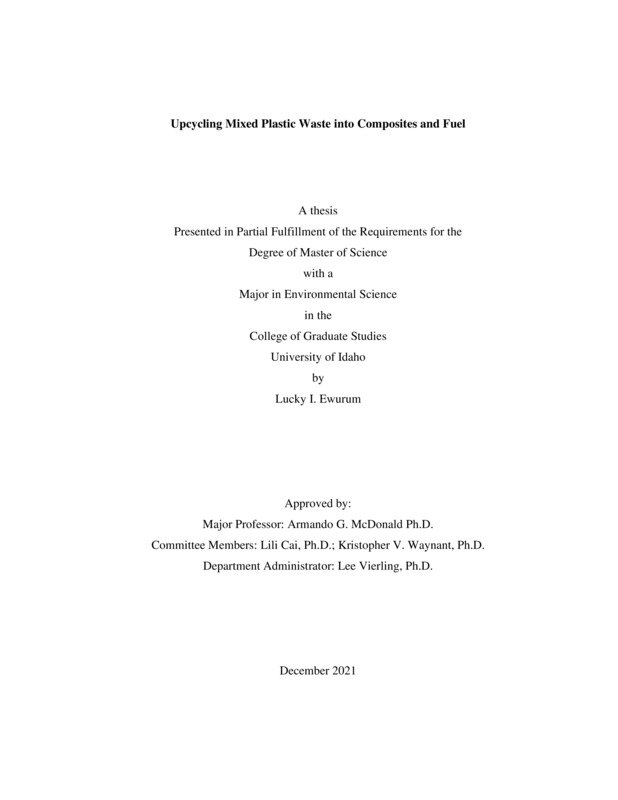Upcycling Mixed Plastic Waste into Composites and Fuel
Ewurum, Lucky Ikenna. (2021-12). Upcycling Mixed Plastic Waste into Composites and Fuel. Theses and Dissertations Collection, University of Idaho Library Digital Collections. https://www.lib.uidaho.edu/digital/etd/items/ewurum_idaho_0089n_12259.html
- Title:
- Upcycling Mixed Plastic Waste into Composites and Fuel
- Author:
- Ewurum, Lucky Ikenna
- Date:
- 2021-12
- Keywords:
- Composites Coupling agents Cross linking Hops fiber Mixed plastic waste Pyrolysis
- Program:
- Environmental Science
- Subject Category:
- Environmental science; Plastics; Energy
- Abstract:
-
Abstract
The growing concern with regards to the amount of mixed plastic waste (MPW) especially in municipal solid wastes (MSW) and with the significant quantity ending up in the landfill has led to search for more sustainable mode of disposal. MPW are the non-recyclable fraction after sorting and it is comprised of single use items, such as packaging, and plastic recycling grades 3-5 generated. Mechanical and chemical recycling can divert these wastes especially MPW containing some paper fibers from the landfill. This study evaluated the mechanical, thermal, and rheological properties MPW in combination with fibers derived from residual hop bines and coupling agents to form composite materials and secondly the thermal deconstruction (pyrolysis) of MPW into liquid fuel. MPW were used to formulate composites. To improve the interfacial bonding between MPW and fibers, maleated polyolefin (MAPE) and glycidyl methacrylate polyolefin were evaluated as coupling agents, while dicumyl peroxide (DCP) was evaluated as a long chain branching and grafting agent in the formulations. The use of the coupling agents, especially MAPE, was observed to increase interaction between the polymer matrix and fiber leading to a better performance in tensile strength. The addition of DCP to the MPW formulations slightly reduced its tensile strength probably due to polymer chain scission. The addition of hops fiber improved the tensile modulus of the composites relative to MPW. For chemical recycling, the homogenized MPW was pyrolyzed (with and without Zeolite Y catalyst) between 500 to 600 °C in a tube reactor. Liquid products were trapped and characterized using a combination of GCMS and ESI-MS. The physical and chemical characteristics of the solid char product were also characterized by FTIR spectroscopy. Pyrolysis products were mainly straight chain hydrocarbons, while catalytic pyrolysis products were short-branched hydrocarbons and aromatics. These results clearly show that catalytic pyrolysis was successful in producing a liquid fuel comparable to gasoline.
- Description:
- masters, M.S., Environmental Science -- University of Idaho - College of Graduate Studies, 2021-12
- Major Professor:
- McDonald, Armando G
- Committee:
- Cai, Lili; Waynant, Kristopher V; Vierling, Lee
- Defense Date:
- 2021-12
- Identifier:
- Ewurum_idaho_0089N_12259
- Type:
- Text
- Format Original:
- Format:
- application/pdf
- Rights:
- In Copyright - Educational Use Permitted. For more information, please contact University of Idaho Library Special Collections and Archives Department at libspec@uidaho.edu.
- Standardized Rights:
- http://rightsstatements.org/vocab/InC-EDU/1.0/

